The Art of Rhinoplasty
Let’s start with the big question: What is Rhinoplasty surgery?
Rhinoplasty, also known as a nose job, is a surgical solution that aims to reshape or reconstruct the nose and change its shape or size for patients who are unhappy with their appearance. Nose job surgery has versatile purposes such as to improve breathing and nasal function after an injury, correct a birth defect or aesthetic deformities, and help patients restore their confidence in their appearance.
Nose surgery (rhinoplasty) is usually an outpatient procedure that takes 1-2 hours. Although nose surgery can be performed with general or local anesthesia, it is generally better performed under general anesthesia to have more control over the tissues and to properly protect the airways.
Keep reading to know more rhinoplasty meaning, the rhinoplasty procedure, and all the details regarding before and after nose job..

The Versatile Applications of Nose Job (Rhinoplasty)
Some people undergo a nose plastic surgery for aesthetic and cosmetic reasons such as to enhance their face appearance by correcting the size and shape of their nose, others have rhinoplasty to improve nasal function, enhance breathing, and correct deformities. Let’s take a deeper look into the purposes of rhinoplasty:
Reduce the nose size: Rhinoplasty is an effective and guaranteed cosmetic solution for those who are unsatisfied with the size of their nose compared to the rest of their factual features. The change in the nose size is carefully discussed with a rhinoplasty doctor who is also a professional surgeon to get the best results and restore the patient’s confidence.
Correct birth defects and other deformities: Nose deformities resulting from a traumatic injury or birth defects such as cleft palates, deviated septum, or even nasal polyps that clog airways. Overgrowth of sebaceous glands and thick nose skin that enlarge the nose size.
Restore the patient’s confidence: This point includes the correction of too wide or uneven nostrils, reshaping nose tip or bridge, or changing the angle between the nose and upper lip to enhance the patient’s confidence or solve breathing problems.
Rhinoplasty Techniques: Open vs Closed Nose Job
The technique used by the plastic surgeon depends on the patient’s goals, case, and what the doctor prefers to obtain satisfactory results.
There are also other non-surgical techniques used for a nose reshaping including nose fillers and nose threads.
However, nose surgery remains the most effective method to get lasting results that can also solve the vast majority of nasal problems.
Closed Rhinoplasty: During this technique, the surgeon will make incisions inside the nostrils with no scar on the visible skin. In this case, the surgeon will have less access to the bone and cartilage structure of the nose, therefore, in the cases that require more changes in the nose tip or bridge, open rhinoplasty is preferred.
Open Rhinoplasty: Surgeons prefer this approach to make both aesthetic and functional corrections to almost all nasal problems including large nose tip, nose deformities, and nose polyps. During open rhinoplasty, the surgeon will make an incision across the columella that allows him to lift the skin and have better vision into the nose cartilage and bone.
Before and After a Nose Job
If you consider undergoing a nose job, there is a number of steps divided between the consultation, preparation before the surgery, and the post operative instructions to get the best results. Here is the details:
Consulting a surgeon: One of the early steps of having a nose job is consulting a professional surgeon to outline your goals and make sure that you know all the details ahead. During the consultation, your surgeon will ask a series of questions regarding your goals, the expected results, and the reasons that you’re having a rhinoplasty.
The surgeon will also check inside and outside your nose for any deformities or nasal polyps. Afterward, you can either show your doctor the nose shape you prefer or ask him to show you before-and-after photos of previous rhinoplasty surgeries.
Pre-operation instructions: Your surgeon will likely recommend you to refrain from all tobacco products, reduce caffeine, and avoid aspirin at least one month prior to the surgery.
One week before the surgery, make sure to prepare your house and comfy spot for a cozy rhinoplasty recovery, keep your healthy snacks and meds within hand’s reach.
To prepare for the anesthesia, you will likely need to fast for several hours.
Steps of nose job The rhinoplasty surgeon will get you prepared for either a general or local anesthesia. Either way, rhinoplasty is an outpatient procedure, which means no hospital stay is needed to recover, therefore, make sure that you have a ride.
For a nose reconstruction or reshaping, the surgeon will make an incision across the columella, the area between your nostrils, this will allow the surgeon to raise the skin and have access to the bones and cartilage.
Open rhinoplasty is a better option if the doctor needs to remove nasal polyps that clog the airways or to make major changes to the nose tip or bridge. If the nose needs reconstruction, the surgeon might take cartilage from other parts of the body, such as ears, to reconstruct the nose, but this is not always needed.
Now after the surgeon makes the desired changes to the underlying structure, nasal skin and tissues are put back in place, and the incisions are stitched up.
Rhinoplasty recovery: Once the nose job surgery is done, you will be sent to the recovery room and stay under medical monitoring as you wake up. When you are awake, your ride can take your home.
The surgeon will give you a list of instructions to follow after the operation for a quick and proper recovery. You can get back to your normal life very shortly after the surgery. Swelling and blue-coloration around the eyes can be seen after the surgery, besides other side effects including nasal drainage, tenderness, bruising, and slight numbness in the nose and the surrounding area, and it’s all normal to experience.
List of rhinoplasty side effects:
- Swelling and tenderness
- Drainage and slight bleeding
- Blue-coloration around the eyes that lasts for a few weeks
- Temporary numbness and decreased sensation in the nose
Rhinoplasty is considered a safe and effective surgical procedure that will give you lasting results. You can see the final results within 6 months of the procedure.
Post rhinoplasty instructions: The surgeon may give you instructions that you will need to follow for several weeks to lower the risk of bleeding and swelling:
Refrain from smoking for at least two weeks after the surgery since smoking can delay recovery and cause infection.
Lay in your bed with your head elevated to avoid any pressure that can affect the nose shape and to reduce the swelling and subside the extra fluid drain.
Avoid strenuous activities such as jogging and running for at least 3 weeks.
Avoid crowded places where you can catch a cold or an infection.
Apply cool compresses to the area under your eyes to reduce swelling and blue-coloration.
Don’t rush to remove the splint or the bandage after the surgery, and wait for at least 1 week before removing it as per the doctor’s instructions.
Use nose taping to reduce swelling and support the nose.
Avoid strong sunlight exposure
After the surgery, the surgeon will cover your nose with a bandage protected by a splint that stays for at least a week, therefore, avoid taking a shower right after the surgery and wait for 1 week at least before showering.
How to Find the Best Nose Surgeon?
Finding a professional nose plastic surgeon is key to get the results you desire and solve any nasal problems. The surgeon’s expertise plays a critical role in the final results, but now that everyone has access to the internet, patients can refer to real people, real patients, and learn from their experience and feedback.
Doctor Tarek Copty helps his patients make the right decision, giving them the chance to see nose jobs before and after photos for real patients, in addition to videos that introduce patients to the rhinoplasty concept and its purposes, whether the aesthetic or functional ones.
Patients Feedback
“I am so happy with my nose! Thank you doctor! So fortunate that I found you and thank you for taking on such a challenge” @Tiffany_CO_TO_CA
“No questions, but a simple thank you for turning my nose into a fine object of art”
“So happy and satisfied with the results, doctor Tarek you’re the best nose surgeon in Jordan. Thank you so much”
“The best nose surgeon in Amman! You performed a nose job surgery for me 4 years ago, and the result is amazing. You corrected a bad nose job I had in the past and now I am very happy with the result! Thank you doctor Tarek Copty!” @Zainab_Kalamchi
“Good morning doctor Tarek Copty! I don’t have any questions but just wanted to thank you and say you’re the best nose doctor in Amman.” @Farah_MK_AbuAlragheb
“This nose surgeon is a real artist! I had a rhinoplasty at his clinic 2 weeks ago. I came from Kuwait and I am so satisfied with the natural and amazing result.” Shm.Alhaj
